When the Tour de France meets the Paris-Roubaix cobbles
How the combination of ASO's biggest races amps up the drama as yellow jersey hopefuls hit the cobblestones

The biggest races of the men's road racing season have always been the Tour de France and Paris-Roubaix. But when the Tour de France organisers decided to include a significant number of cobbles from 'The Hell of the North' in the first week of the 2010 Tour de France, for the first time in 25 years, there was a mix of anticipation, excitement and fear in the peloton.
It was a controversial and thrilling experiment, and since that year, the Tour de France has included some sectors of pavé in Northern France three more times – in 2014, 2015 and 2018 – each to differing effect. Cyclingnews looks back at these hellish stages of the Tour de France.
Riding cobblestones takes raw power. Every bump over the stones lifts the tyres imperceptibly off the surface, robbing the rider of forward momentum so each pedal stroke needs to be forceful. The faster one goes over the pavé, the smoother the ride. There is no going easy over cobbles, even if they're flat.
It's the contact points suffer the most – palms are rubbed raw and fingers go numb with the jarring, threatening the fine motor control needed to steer the bike. One has to find the right line – the surface will typically have a crown in the middle and deep ruts on each side, with dirt and mud piled up on the verges. The best line might be on the crown but one wrong move and you're sliding – and that is when the section is straight. The turns are even more treacherous.
As Greg LeMond wrote in his Cyclingnews blog in 2010: "A stretch of cobbles was like climbing a steep, short hill; the faster you rode over them, the smoother it was, and so when we reached the pavé section, we hammered it going into them and until we got out the other side. They were also very technical as you had to look ahead and pick your line, reading what the cobblestones were like. You'd have to avoid the sharp stones, jump over the missing ones, and avoid the head of the rider who just fell in front of you."
Including these rough, ancient cobblestone roads in the Tour de France has been met with controversy - is it fair to force tiny climbers into the domain of the hard men of the spring Classics? As the cliché goes - you might not win the Tour on them, but they could bring your race quite quickly to an end.
2010, stage 3: Hushovd wins as Schleck surprises
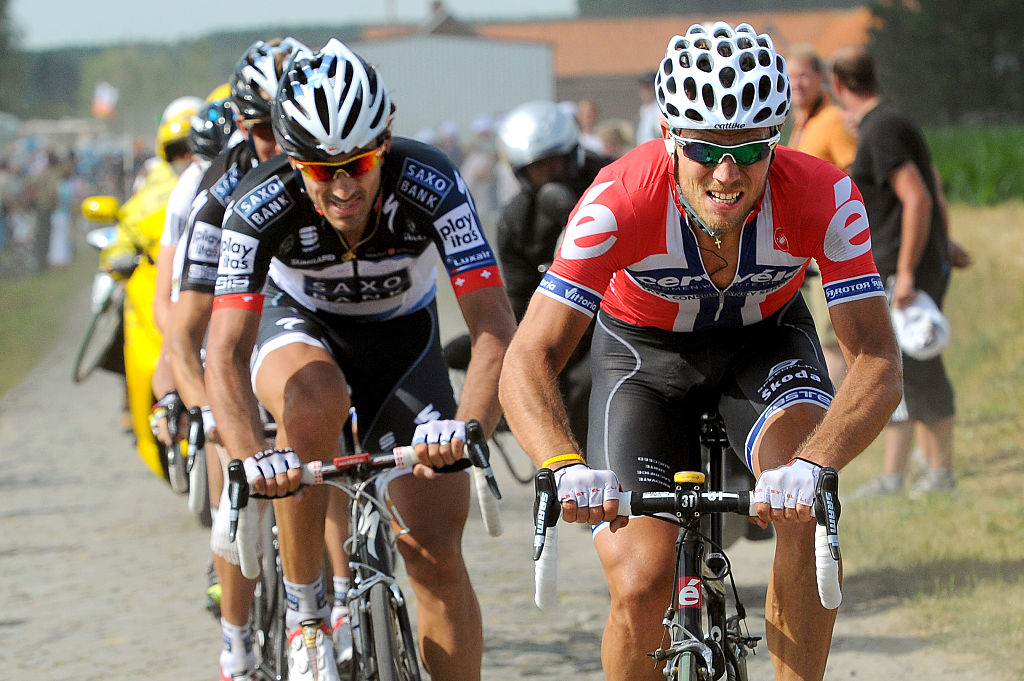
There had been a few cobbled stages in the Tour de France in the 1980s before they fell out of favour. In 2004, stage 3 of the Tour de France included just an amuse-bouche of pavé – a mere 3.5km out of a 210km stage to Waterloo – and still Iban Mayo's Tour de France hopes ended with a crash on the cobbles and almost four minutes lost to the leaders on a day that was warm and dry.
Get The Leadout Newsletter
The latest race content, interviews, features, reviews and expert buying guides, direct to your inbox!
But in 2010, the Tour de France organisers decided to revisit the Paris-Roubaix cobbles and included a much more significant number of sectors, packing 13.15km of pavé into the final 30km of a 213km stage from Wanze to Arenberg, and everyone was predicting 'carnage'.
Lance Armstrong, in the second year of his comeback before getting banned for life, said before the 2010 stage: "It's going to be a critical day. I predict that there'll be 20 or 30 riders left in front. There's no comparison with the stage to Wasquehal in 2004; there are more sectors of pavé, they're harder and they're closer to the finish."
You never know what you'll get with the cobbles. In the dry, the dust makes the surface slippery, and in the wet, the mud turns pavé into a skating rink. Riding them takes skill and experience. This is why, in 2010, defending Tour champion Alberto Contador brought in Classics specialist Peter Van Petegem to teach him how to survive and thrive on the pavé. His 2009 rival Andy Schleck, however, had a secret weapon in Paris-Roubaix winner Fabian Cancellara to expertly pilot the Luxembourger through the frantic stage.
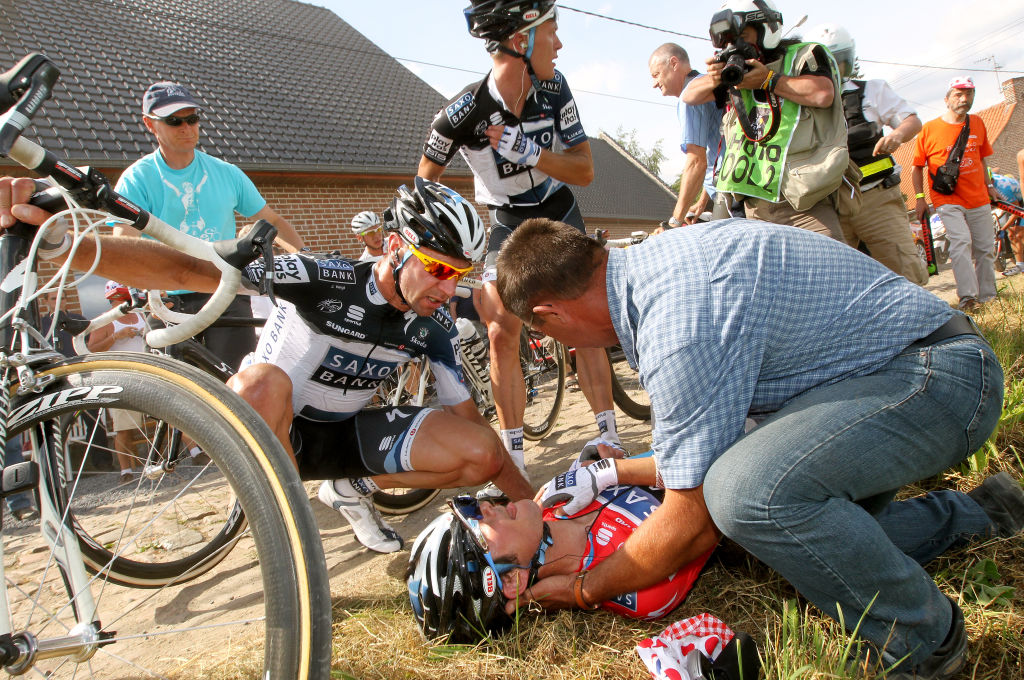
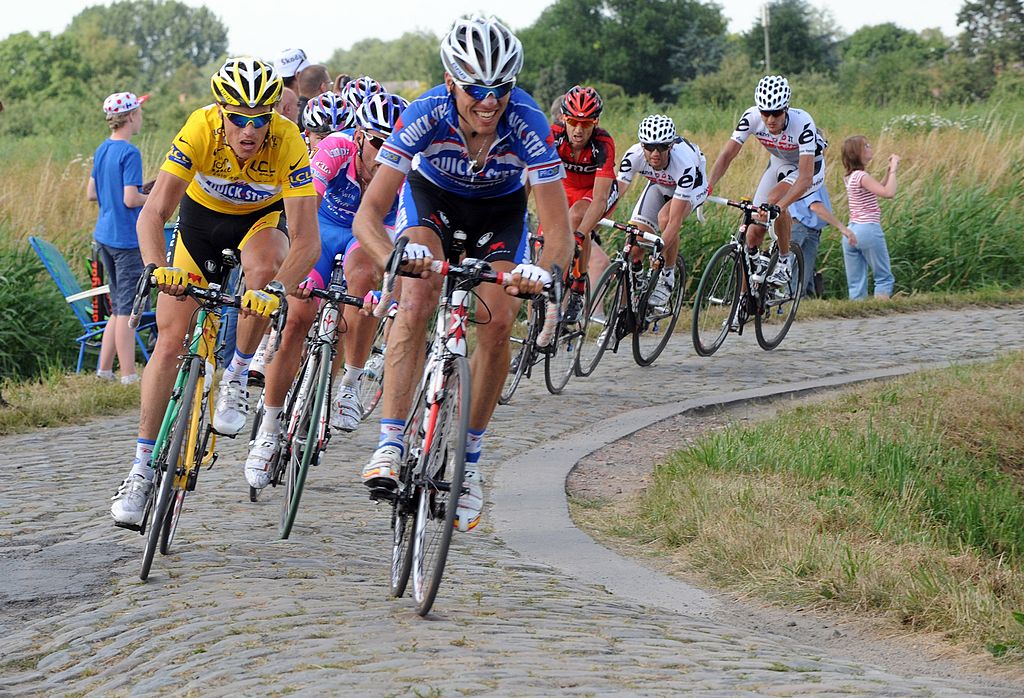
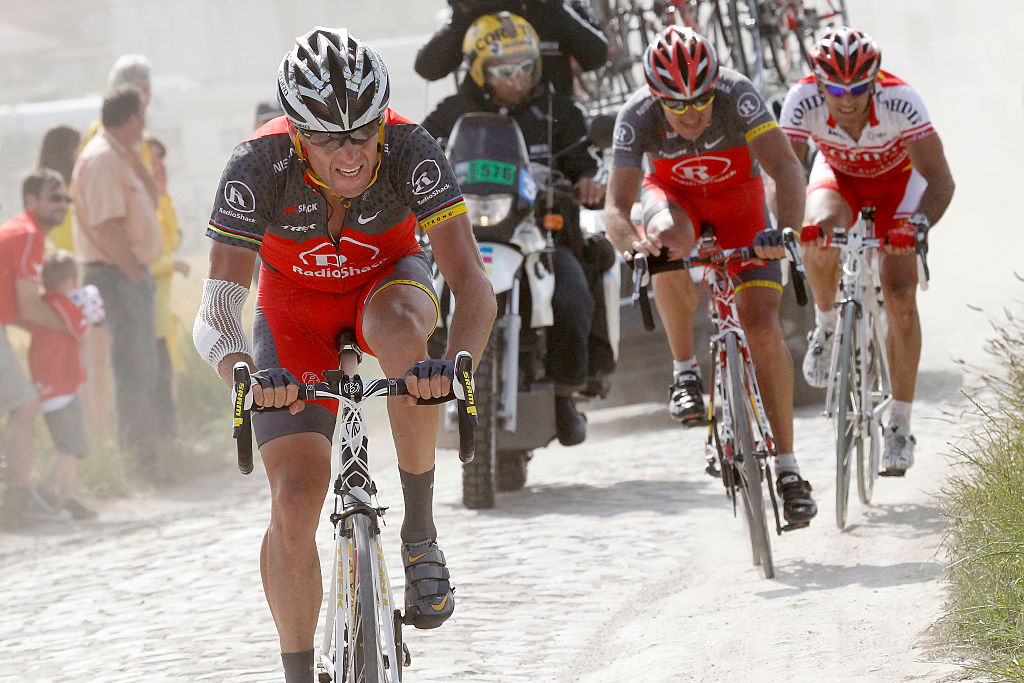
On the morning of the stage in Wanze, there was a little relief in the clear skies and warm temperatures. Sylvain Chavanel had taken the maillot jaune off Cancellara on the previous day as the Saxo Bank team neutralised the bunch sprint after Andy Schleck crashed twice on the slippery, wet roads in the Ardennes. The team was fully focused on keeping Schleck out of trouble.
The peloton sprinted across the first two of seven pavé sectors – Ormeignies and Hollain – but on the third at Sars-et-Rosière, the first mayhem ensued when Fränk Schleck crashed hard and shattered his collarbone. The peloton fractured into several different groups and closing gaps was made even more difficult by the tailwind.
Contador ended up in a second group and chasing alone to the finish after teammate Alexandre Vinokourov failed to wait, losing 1:13. Armstrong, who punctured on the next sector, was forced into a dusty chase in the wake of the lead group's convoy, coming in over two minutes back.
Meanwhile, up ahead, Schleck demonstrated a kind of grit and forcefulness that went counter to his gentle demeanour, following Cancellara through the worst sectors and even driving the pace to keep Contador at bay.
Thor Hushovd claimed the stage win (over none other than future Tour winners Geraint Thomas and Cadel Evans, the world champion at the time), and Cancellara regained the maillot jaune.
Despite riding well over the final sectors and gaining time on Contador, Andy Schleck was disappointed for his brother, joining him in decrying the inclusion of cobbles in the Tour: "A stage like that doesn't fit the Tour de France. For me, it was a good stage, though. I prepared for it well and managed to get a good result. But for those who want to ride the cobbles, there's Paris-Roubaix, but that's their choice. It shouldn't be in the Tour de France."
2014, stage 5: Nibali dominates as Boom wins the stage
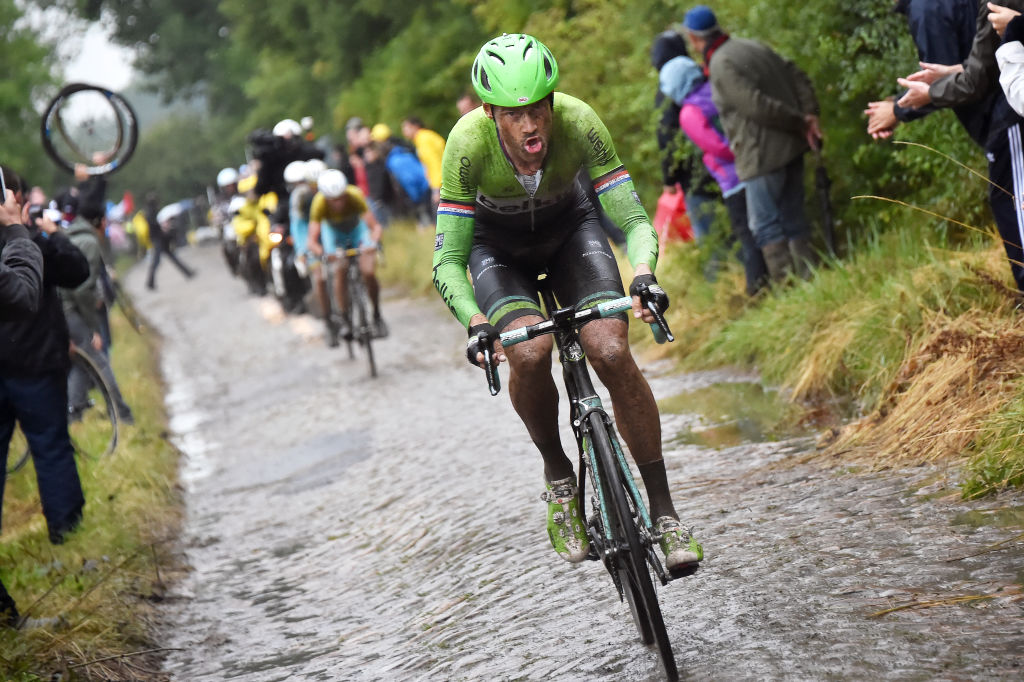
While 2010 provided ample drama, it was nothing compared with what went down in the 2014 Tour de France on a cold and rainy stage 5 from Ypres to Arenberg. Vincenzo Nibali had already shown he was on flying form with a stage win in Sheffield in the UK on stage 2, where he took the maillot jaune off Marcel Kittel and was still wearing it at the start in Ypres. With Peter Sagan in second overall at two seconds, all eyes were on the Slovakian.
The peloton should have faced nine sectors of cobbles and 15.4km in total, with the first – the five-star Carrefour de l'Arbre – with over 68km to go. But organisers removed two stretches before the start because of the weather, with the Orchies and Mons-en-Pévèle sectors deemed too dangerous in the rain, reducing the total to 13km.
Defending Tour champion Chris Froome had crashed on the previous stage and injured his wrist. He crashed again just 30km into the stage and again just before the race even hit the cobbles, and abandoned the race in agony.
The race was swinging well into Nibali's corner and, with his famous bike-handling skills and a strong team surrounding him, the Italian was right up front along with Contador when they entered the first sector of pavé, but the Spaniard looked much less comfortable on the second and was soon tailed off. Seeing this, Nibali himself went to the front to drive the pace, but also had ample help from teammates Jakob Fuglsang and, after he came back from the breakaway, Lieuwe Westra.
So dominant were Astana on the stage that, coming out of the last sector with Nibali on their wheel, they even opened a gap to specialist Lars Boom. The Dutchman rejoined and won the stage, but Nibali and Fuglsang drove the gap to the next-best GC favourite, Richie Porte (then Team Sky), to almost two minutes, with Contador 30 seconds further back and Froome out of the race.
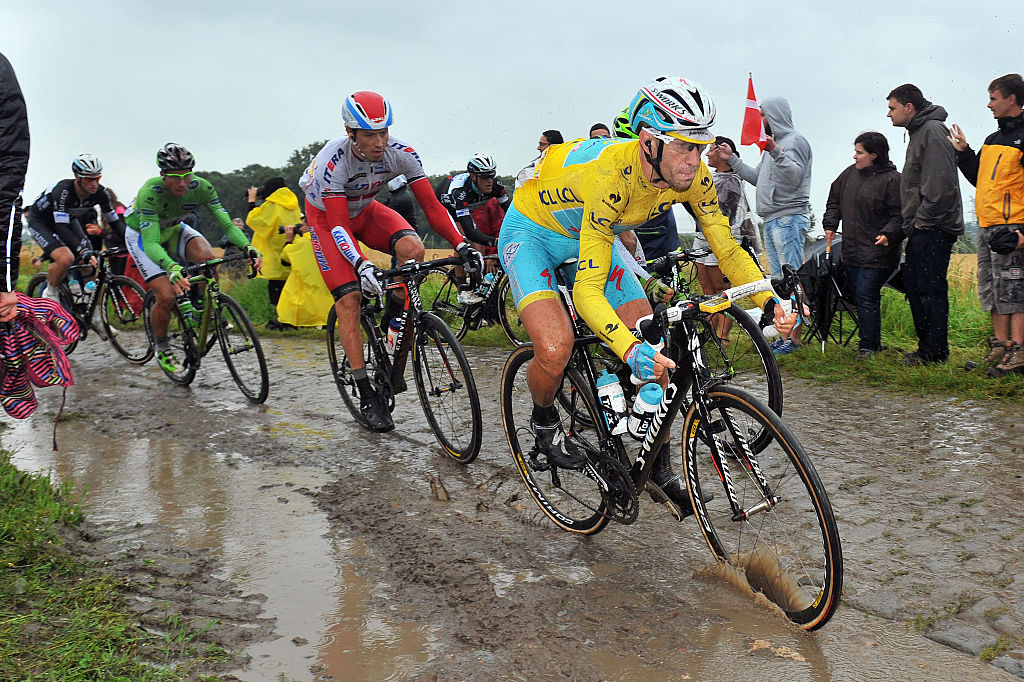
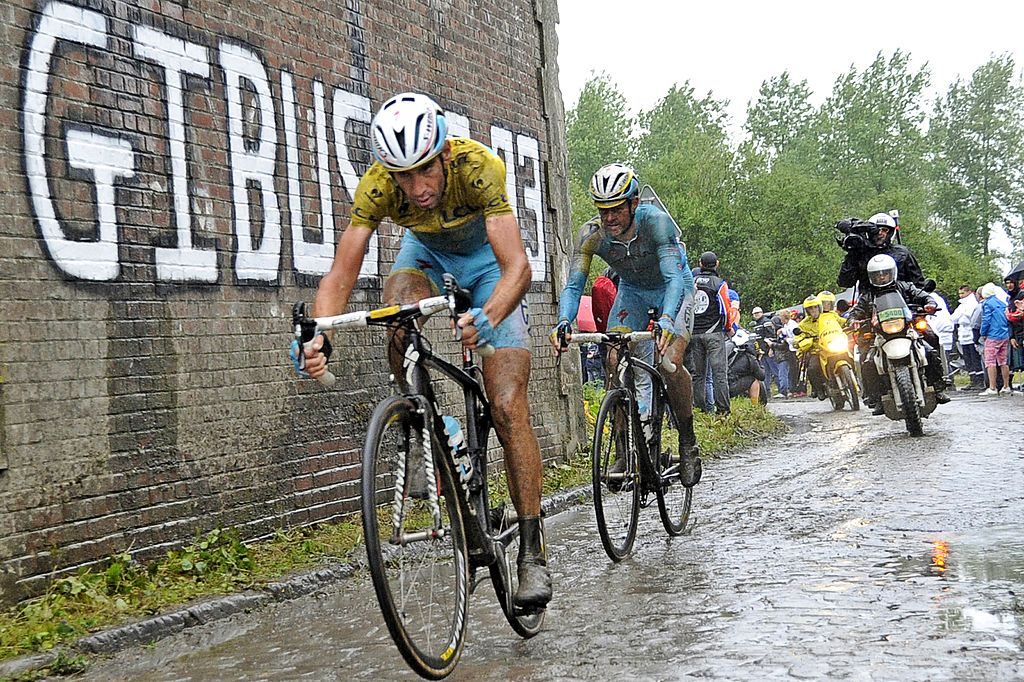
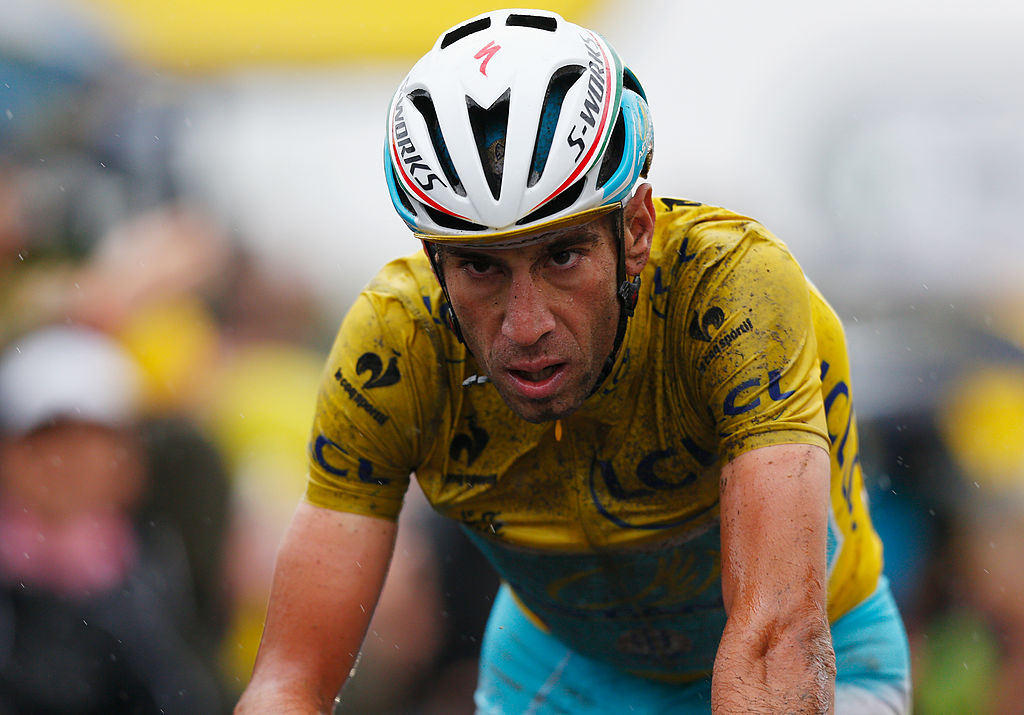
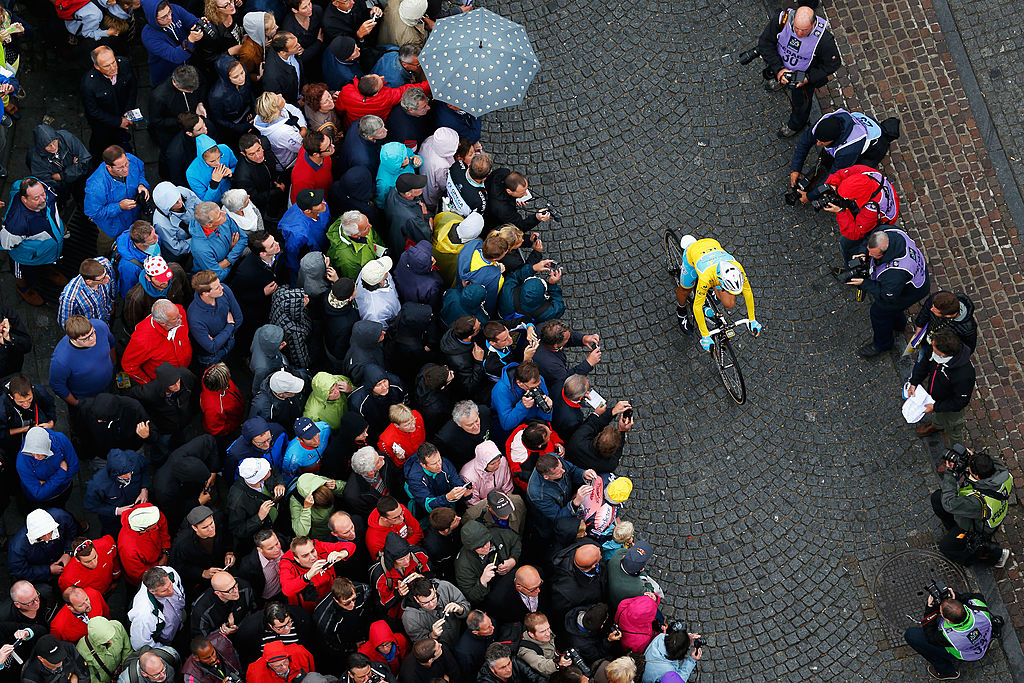
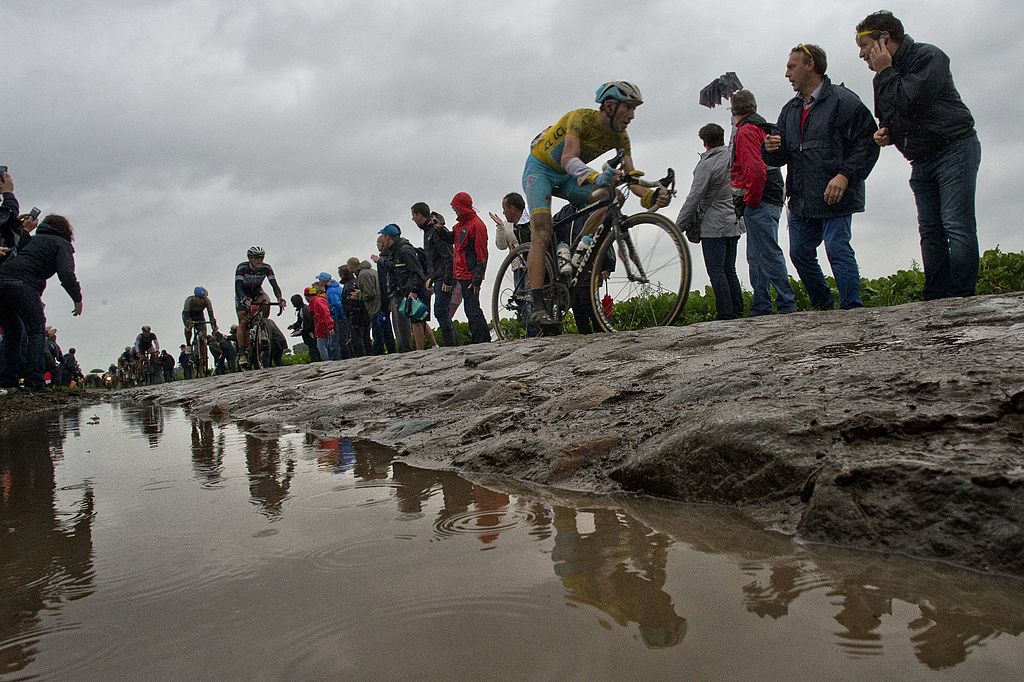
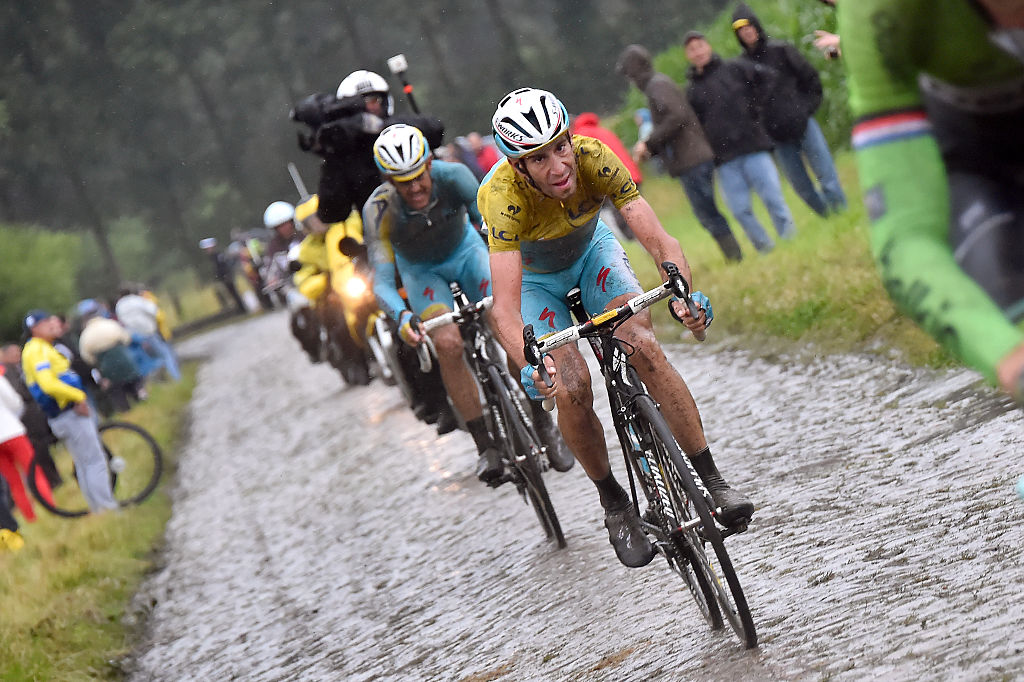
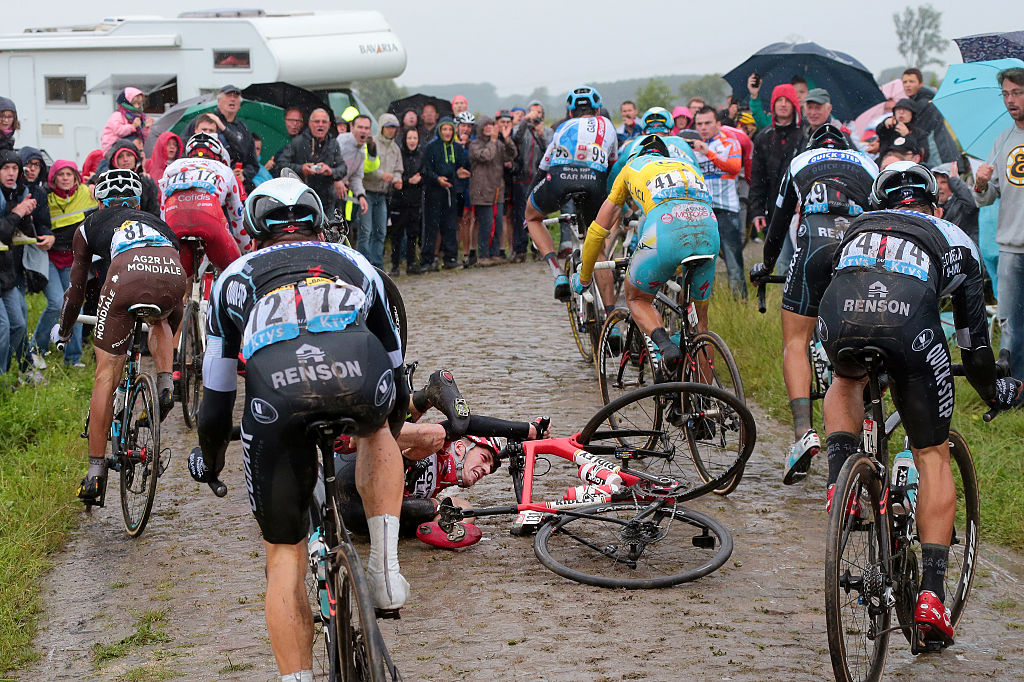
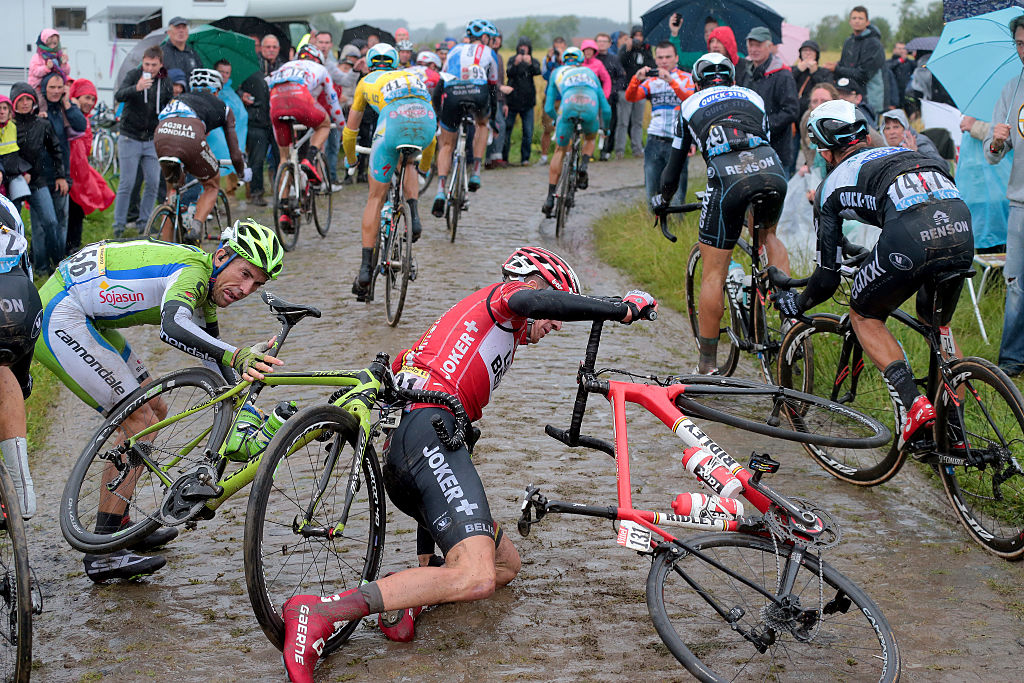
It was only the start of Nibali's dominance that would see him win the Tour by more than seven minutes over Jean-Christophe Péraud and Thibaut Pinot. All talk after the stage centred on Nibali's bike handling and prowess in all conditions and courses, and pundits hailed him a complete rider.
Stage 5 of the 2014 Tour de France was, at the time, the biggest traffic day in Cyclingnews' history. After years without a wet Paris-Roubaix, the stage whetted the fans' appetites for unpredictable, chaotic and exciting racing and tore up the script of the typical first-week sprint fest in the Tour de France.
Not everyone was happy about the stage, however. Fabian Cancellara, who tried to protect GC leader Fränk Schleck (after Andy retired), even turned against the inclusion of the pavé.
"The race was a mess. When I heard on the radio what was happening just with our riders, I could imagine what must be happening with the others. In my opinion, this does not have a place in a Grand Tour," Cancellara said. "It was completely different than in April because the field is so different. Also the wet roads made it very dangerous – the whole course was now dangerous."
2015, stage 4: Tony Martin foils the sprinters
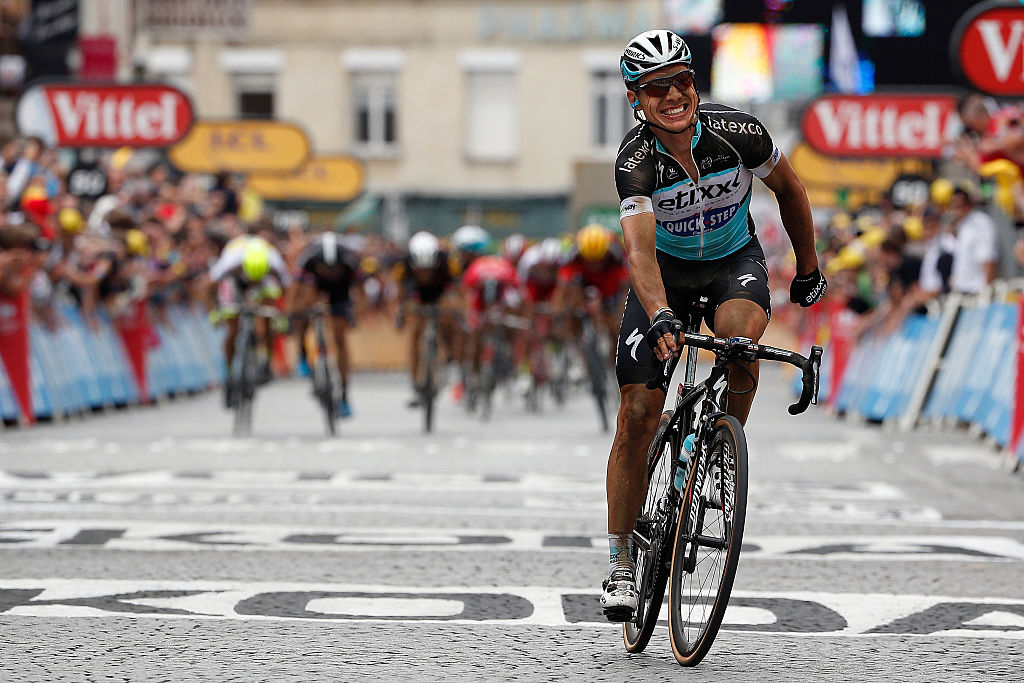
Organisers, seeing the success of the 2014 stage, cooked up another cobbled stage for the 2015 edition of the Tour de France, on the longest stage of the race to boot. Running 223.5km from Seraing to Cambrai, the stage included seven sectors, but none nearly as bad as the ones used in 2014 and 2010.
Chris Froome (Team Sky) came into the stage as the unexpected race leader after the peloton split in the heavy crosswinds of Zeeland on stage 2 and after escaping with Joaquim Rodríguez on the Mur de Huy on stage 3.
The first section of pavé came mid-stage, with the Pont-à-Celles in Belgium, then the 1200m Route de Artres, the three-star Quérénaing and Verchain-Maugré sectors with 38km to go, followed by the four-star St Python and three-star Quiévy and, finally, the Carnières with 10km to go.
With more pleasant conditions than in 2014, there were no big separations on the pavé, despite Nibali trying to force the issue. Froome, Contador, Nibali and Nairo Quintana – the pre-race favourites – all finished in the same first chasing group behind stage winner Tony Martin, who stuck in a brave solo attack.
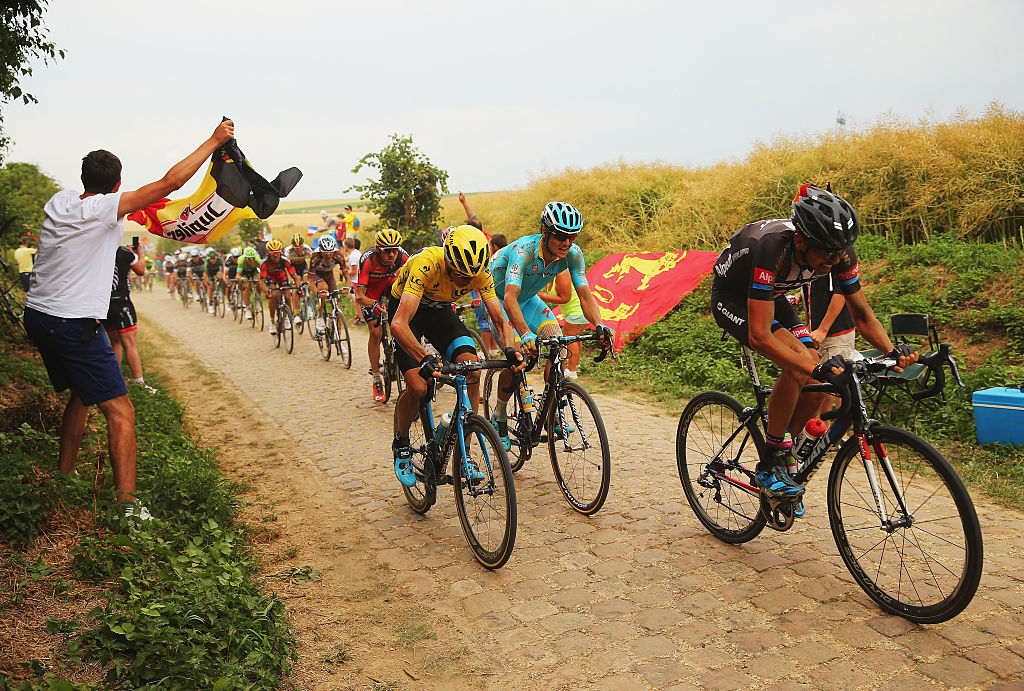
Tony Martin had been close to taking the race lead, first in the opening time trial, then in the crosswinds on stage 2 – where his team botched the sprint and let Fabian Cancellara take a time bonus and move into yellow – and again on stage 3 when Froome jumped away and took the race lead by one second over Martin.
Despite having had a mechanical and taken teammate Matteo Trentin's bike with the wrong position, Martin found an opportunity to attack with 3.5km to go, and this time he held off the chasing peloton by a slim three seconds to finally move into the maillot jaune.
As most of the GC favourites finished together and Martin's ecstatic victory provided a nice plot twist to the expected bunch sprint, there were few who denigrated the inclusion of cobbles in the Tour de France in 2015, except for Thibaut Pinot, who suffered a puncture and mechanical in the penultimate sector and shed over three minutes.
2018, stage 9: Degenkolb and hardly a dry eye in the house
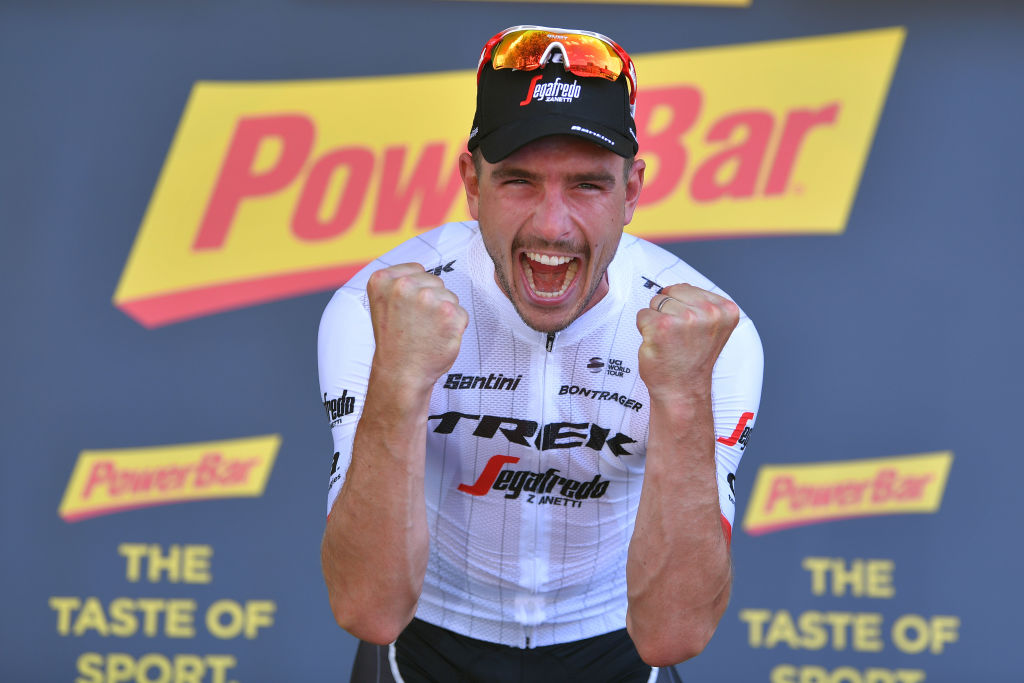
After a relatively calm foray into the cobbles of Paris-Roubaix in 2015, the 2018 Tour de France upped the ante with a full 21.7km of pavé across 15 sectors spread over the final 109km of the stage, making for plenty of opportunities for riders to come to grief. Once again, it was a bright, sunny day for the stage, so there would be none of the slick muddy sectors, but the stage would live up to its nickname – the mini-Paris-Roubaix.
The general nervousness of the Tour de France that typically shrouds the opening week of the Tour should have been somewhat lessened since the stage came on day nine. Greg Van Avermaet held the race lead after BMC dominated the stage 3 team time trial, and, aside from stage 6 finishing on the Mûr de Bretagne, the rest of the stages finished in bunch sprints.
But there were still plenty of fresh legs in the peloton and, heading into the stage, the general classification contenders were mostly all within two minutes of Van Avermaet. Also close in the GC was Classics specialist Philippe Gilbert, with Peter Sagan hoping to take the stage after winning Paris-Roubaix earlier in the year.
Sky's Geraint Thomas had raced a perfect first week and was sitting second overall at three seconds. Chris Froome had crashed in the closing kilometres of the opening stage and was a minute behind his teammate. Nibali, so dominant on the stage in 2014, was at 1:12 and now a rival of former teammate Fuglsang.
Coming two days before an abrupt transition to the first major mountain stage to Le Grand Bornand – one that crossed the Col de la Croix Fry, Montée du plateau des Glières, Col de Romme and Col de la Colombière – the GC contenders had quite a balancing act on the tricky stage to Roubaix. There is no easy stage in the Tour, and a flat stage with cobblestones would take all of their mental energy, as well as a fair bit of effort before the first rest day.
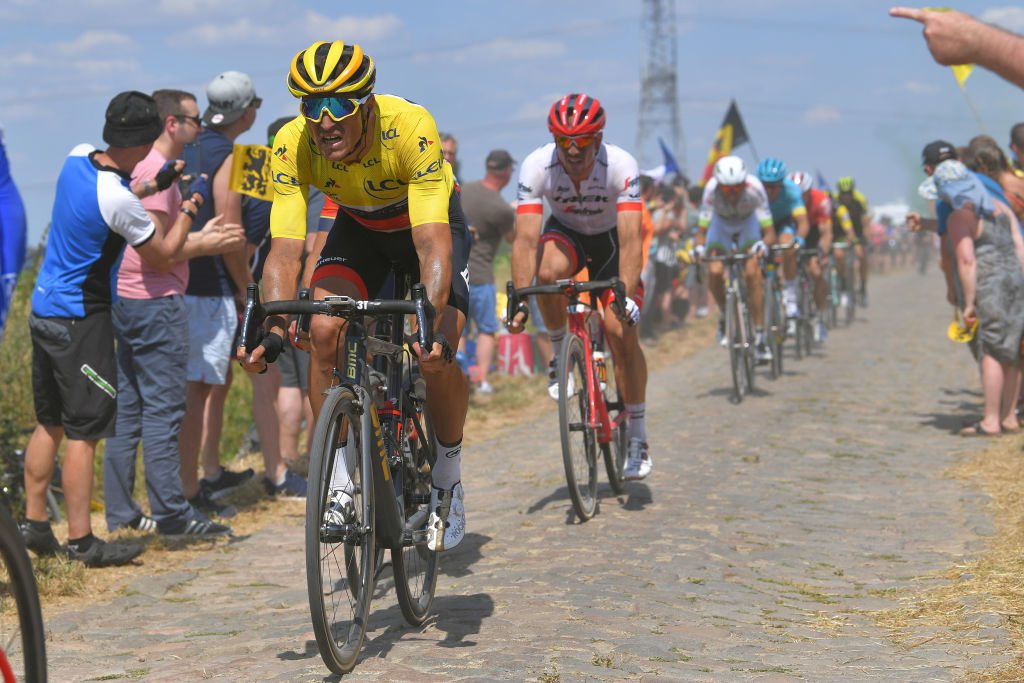
The first victim of the stage was the unlucky Richie Porte, who crashed out of the race before the first cobbled sector – stage 9 proving to be his downfall as it was in the previous Tour. The next mishap fell on Romain Bardet, who suffered a puncture as Bora-Hansgrohe drove the pace for Sagan across the cobbles and, still chasing with a minute gap to make up, Badet had to change his bikes twice.
The stage had all the pacing and plotlines of Paris-Roubaix, with the sectors coming one after another and mass chaos ensuing as Sagan's team tried to control a breakaway. A large crash in the peloton occurred at Warlaing à Brillon, sector 12, just after the halfway point of the stage, with Nibali ending up on the wrong side of the split. The group came back together by sector 9 at Auchy à Bersée with 50km to go, and Bardet suffered another mechanical.
Crashes kept coming, with Michał Kwiatkowski (Team Sky) tumbling in a turn on the Pont-Thibault à Ennevelin sector with 35km to go, and Mikel Landa (Movistar) falling while taking a drink a few kilometres later. Gilbert crashed on the way off sector 5 at Templeuve, while Rigoberto Urán (EF) lagged behind after a fall off camera.
But, for all the build-up and focus on the GC riders, the only riders to lose time in the end were Landa and Bardet at just seven seconds, and Uran at 1:28. All the rest finished together behind a thrilling race between the cobbled Classics specialists.
Sagan missed the move when Yves Lampaert attacked, taking overall leader Van Avermaet and 2015 Paris-Roubaix winner John Degenkolb with him.
It had been a rough time for the German, who had been involved in a horrific crash at a team training camp in early 2016 when a driver on the wrong side of the road crashed into the group. Degenkolb's left index finger was nearly severed and he had to undergo months of rehabilitation.
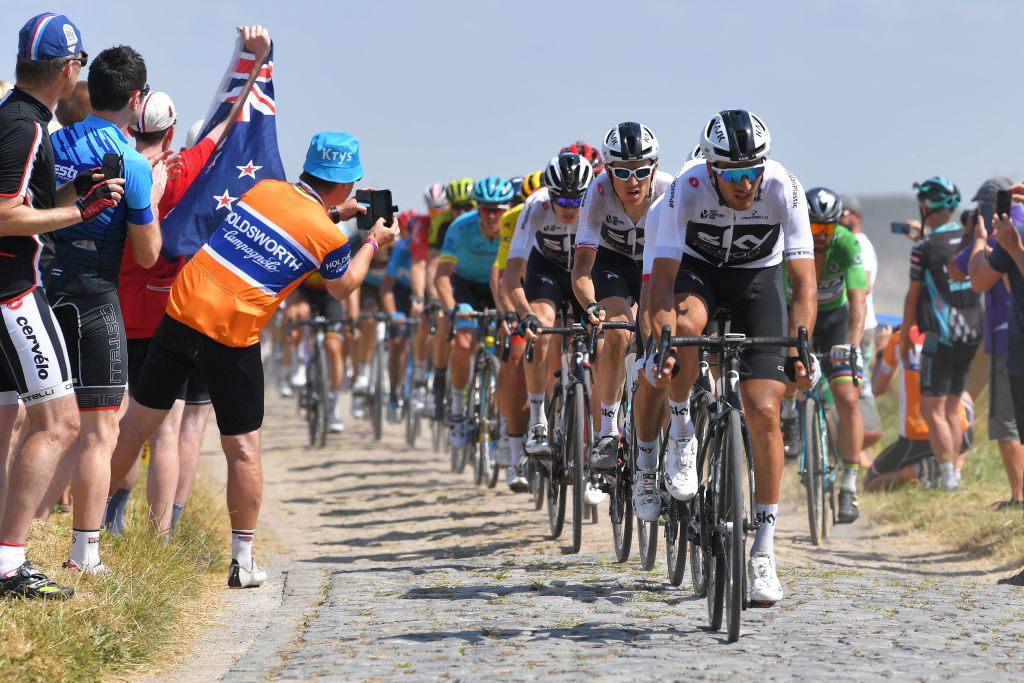
It was a bitter pill after the success of the previous year, where he won both Roubaix and Milan-San Remo, as well as the final stage of the Vuelta a España in Madrid. He then suffered the loss of a close family friend in 2017. But Degenkolb was certainly no underdog in the trio, and when it came to the final kilometre, Van Avermaet had pinned him to the front and refused to come through.
Looking back the whole time, waiting for the attack to come, Degenkolb led the breakaway into the final few hundred metres and then, with just over 200m to go, opened up his sprint from the front. Suddenly, it was 2015 all over again – Van Avermaet could not even draw alongside.
The joy and relief flooded Degenkolb's face and it seemed the entire cycling world was overjoyed for the German, who said the following day: "I needed two or three secretaries to manage all the congratulations."
It just goes to show that the cobbled stages of the Tour de France don't always have to end up in carnage or splits among the GC favourites. They can provide something as satisfying as seeing a worthy winner find success after a long drought, or watching a tenacious solo effort hold off the charging bunch.
But when it comes to drama, the Tour de France plus Paris-Roubaix is always going to equal something special. It's rare to see this magic combination but when it comes, it will inevitably be a day to remember.

Laura Weislo has been with Cyclingnews since 2006 after making a switch from a career in science. As Managing Editor, she coordinates coverage for North American events and global news. As former elite-level road racer who dabbled in cyclo-cross and track, Laura has a passion for all three disciplines. When not working she likes to go camping and explore lesser traveled roads, paths and gravel tracks. Laura specialises in covering doping, anti-doping, UCI governance and performing data analysis.